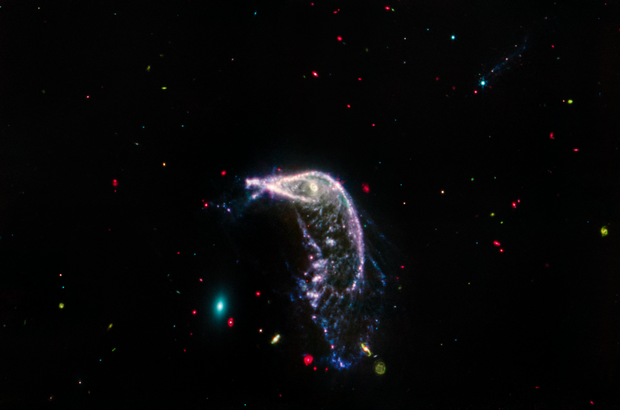On Friday, to mark the second anniversary of the James Webb Space Telescope’s operation, NASA released a breathtaking new cosmic image of two galaxies merging together.
The telescope, which GOING on December 25, 2021, has transformed the field of astronomy with stunning images that are helping researchers unravel some of the mysteries of the universe.
The James Webb Space Telescope is a collaborative effort between NASA, the European Space Agency and the Canadian Space Agency. Unlike the Hubble Space Telescope, which orbits the Earth, the Webb orbits the sun at a distance of about 1 million miles away from Earth.
The image released Friday depicts two merged galaxies, known collectively as Arp 142, and aptly nicknamed “The Penguin and the Egg.” “Penguin” is the penguin-like distorted spiral galaxy in the middle, while “Egg” is the elliptical galaxy on the left. The Penguin and the Egg are estimated to be about 100,000 light-years apart, a surprisingly close distance in astronomical terms.
NASA, ESA, CSA, STScI
Arp 142 is located 326 million light years from Earth in the constellation Hydra. NASA says the two galaxies first interacted between 25 and 75 million years ago and will complete several additional loops before merging into a single galaxy hundreds of millions of years from now.
If you take a moment to scan the background, the Webb image is filled with distant galaxies. Some appear in spiral and oval shapes, while others are scattered as shapeless dots. This is a testament to the impressive sensitivity and resolution of the telescope’s infrared instruments.
Webb, often referred to as a “time machine,” studies every phase of the universe’s history, from the initial radiant glows after the Big Bang to the evolution of our solar system.
“We’re really understanding and starting to get new information about how the first galaxies formed and evolved in the universe,” Mark Clampin, director of the astrophysics division at NASA headquarters in Washington, told CBS News.
He explained that unlike the Hubble telescope, Webb “can see inside these huge dust clouds and start studying the stars as they form.”
This allows scientists to watch these stars evolve and study how the planetary systems around them are born.
“And then, of course, we want to understand the nature of exoplanets,” Clampin said, referring to planets outside our solar system, “and ultimately start trying to find evidence of habitability.”
Webb has been observing potentially habitable planets ever since PLACEMENT. NASA reported that it currently knows about 30 planets that could be “small, rocky Earth-like planets orbiting in the habitable zone.”
Webb’s extraordinary sensitivity allows it to discover and begin to characterize the atmospheres of several promising, potentially habitable planets orbiting cool stars, identifying molecules essential for life such as water vapor, methane and carbon dioxide .
“In just two years, Webb has transformed our view of the universe, enabling the kind of world-class science that drove NASA to make this mission a reality,” Clampin said. “Webb is…entering a new era of studying distant worlds, while returning images that inspire people around the world and posing exciting new questions to answer. Never before has it been possible to explore every aspect of the universe.”
